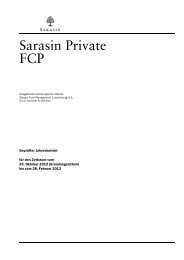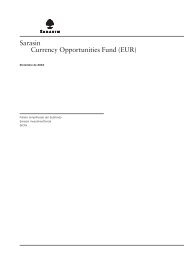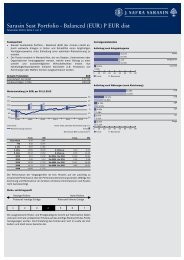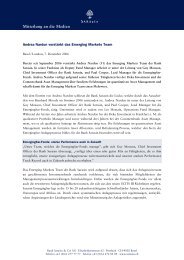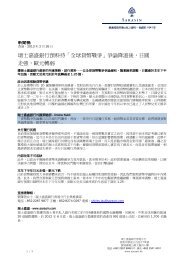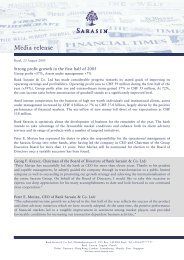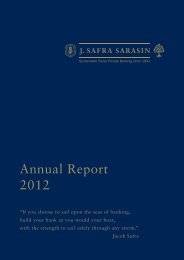Annual Report 2012 - Bank Sarasin
Annual Report 2012 - Bank Sarasin
Annual Report 2012 - Bank Sarasin
Create successful ePaper yourself
Turn your PDF publications into a flip-book with our unique Google optimized e-Paper software.
capital, and the credit quality of the<br />
respective counterparty. Ultimately it is<br />
up to the Central Credit Committee (CCC),<br />
following an application by the Risk Office<br />
(RIOF), to approve the loan and decide on<br />
the amount of credit granted. In parallel<br />
with the CCC decision, the limits must<br />
also always be approved by the Group<br />
Oversight Committee (GOC) of J. Safra<br />
<strong>Sarasin</strong> Holding Ltd based on its own<br />
credit assessment. This process does not<br />
apply to credit limits for the Treasury Bond<br />
Portfolio, which (as mentioned previously)<br />
are assessed at the request of RIOF both<br />
by <strong>Bank</strong> <strong>Sarasin</strong>’s Investment committee<br />
and the holding company's GOC. As a<br />
general rule, the emphasis when<br />
conducting business on the interbank<br />
market is on the quality of counterparties,<br />
with consideration given to risk-reduction<br />
measures wherever possible.<br />
Concentrated risks<br />
Concentrations of risk are monitored on a<br />
by-counterparty basis and are based on<br />
the provisions of the Swiss Ordinance on<br />
Capital Adequacy and Risk Diversification<br />
for <strong>Bank</strong>s and Securities Traders (ERV). A<br />
group of related counterparties is<br />
regarded as a single counterparty.<br />
Concentrations of risk are risk-weighted.<br />
The upper limit per counterparty is 25% of<br />
the eligible capital calculated in<br />
accordance with the statutory<br />
requirements. While client receivables are<br />
mostly covered by readily realisable<br />
collateral and therefore do not represent<br />
concentrations of risk in the regulatory<br />
sense, the Risk Office (RIOF) checks prior<br />
to entering into positions involving nonclients<br />
that the critical size of the<br />
concentrations is not exceeded.<br />
Liquidity risk<br />
The liquidity risk essentially refers to the<br />
danger of the bank being unable to meet<br />
its payment obligations or failing to meet<br />
the requirements imposed by banking<br />
regulations. On the other hand there is a<br />
risk of a lower return in the case of<br />
holding excessive liquidity.<br />
<strong>Bank</strong> <strong>Sarasin</strong>’s Treasury Committee is<br />
responsible for monitoring liquidity. It is<br />
composed of the Group Treasurer, the<br />
CFO, the Head of the Trading & Family<br />
Offices division, representatives of the<br />
specialist departments and of the Risk<br />
Office, and usually meets every two<br />
weeks. The prime objective is to<br />
guarantee the <strong>Bank</strong>’s ability to meet its<br />
payment obligations at all times and to<br />
make sure legal requirements for liquidity<br />
are complied with.<br />
A key task of the committee is to monitor<br />
all the relevant liquidity risk factors. These<br />
include money flows between subsidiaries<br />
and the parent, inflows and outflows of<br />
client funds and changes in the availability<br />
of liquidity reserves.<br />
Especially in times of crisis, unsecured<br />
borrowing from third-party banks may turn<br />
out to be extremely difficult. In its financial<br />
investments <strong>Bank</strong> <strong>Sarasin</strong> therefore keeps<br />
significant holdings of liquid bonds that<br />
are eligible for repo transactions and<br />
which can be used at any time to generate<br />
liquidity. As a supporting strategy, target<br />
bandwidths are set for surplus coverage of<br />
the minimum reserve as well as for<br />
minimum liquidity. These are actively<br />
monitored and adequate measures<br />
initiated if liquidity falls below the<br />
specified targets.<br />
After the closing of the acquisition, a new<br />
internal liquidity requirement was also<br />
defined which is geared towards the<br />
elements of both the current (Liquidity II)<br />
and future regulatory rules (Liquidity<br />
Coverage Ratio).<br />
Operational liquidity management in the<br />
day-to-day running of the business is<br />
handled by the Trading Money Market<br />
department (part of the TFO division). Its<br />
tasks include controlling payments,<br />
planning the anticipated cash flows and<br />
securing liquidity in the day-to-day<br />
business.<br />
<strong>Bank</strong> <strong>Sarasin</strong> & Co. Ltd, <strong>Annual</strong> <strong>Report</strong> <strong>2012</strong> | 67



